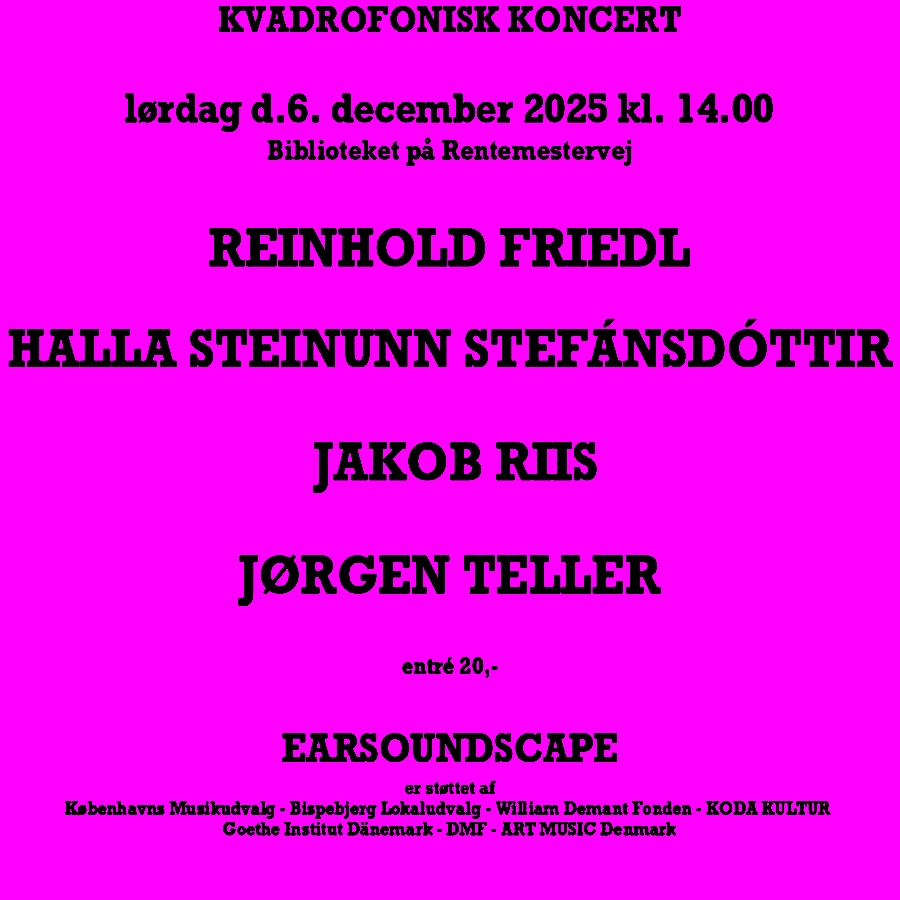
Head to Venice and Hear Foreign Songs Everywhere
The French Pavilion smells of lavender. Visitors slowly move through an organic sculptural installation accompanied by fashion-show-like electronic music. It feels like walking through a chic boutique. Poet, composer, and performer Julien Creuzet’s aesthetic, with a Caribbean touch, feels completely immersive and familiar. And with this privileged gaze, hearing, and sense of smell, you enter the many multisensory spaces at the 60th Venice Biennale.
Even Björk sailed into Venice to give a secret DJ set in a palazzo, of course wearing a mask
With the theme Stranieri Ovunque – Foreigners Everywhere, curator Adriano Pedrosa gives a voice to the marginalized, the colonized, refugees, outsider artists, and folk artists from the Global South. You can feel it, tactilely, in the many textile works from Colombia and Chile – the works scratch. Though Chinese artist Xiyadie’s erotic paper cuttings seem innocent, they stand in sharp contrast to the war, refugees, and destruction that have become an unavoidable reality in 2024.
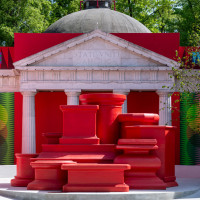
But there are also numerous immersive spaces with scents and sound in the national pavilions: 16 perfumes play as important a role as the solitary sculpture in the South Korean Pavilion. The Neighbours in the Bulgarian Pavilion is a multimedia installation reflecting on forgetfulness and memory during Bulgaria’s socialist era from 1945-1989. And when the ritualistic drums sound in the Belgian Pavilion, the giant puppets seem as if they might come to life. Jeffrey Gibson, who has painted every inch of the American Pavilion, references songs by Tracy Chapman and Nina Simone, so you hear their iconic raspy voices inside as you are overwhelmed by bold colors. In the Giardini – outside the Israeli Pavilion that was closed by the artist – flash mob protests are heard, railing against the destruction in Gaza. Even Björk sailed into Venice to give a secret DJ set in a palazzo, of course wearing a mask.
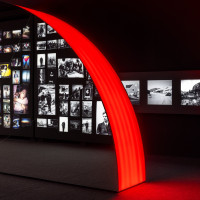
And because there is so much sound in Venice, the shamanistic rituals in Inuuteq Storch’s lyrical photographs of the Kalaallit people in Greenland whisper and drum in the Danish Pavilion. Otherwise, the pavilion is entirely silent.
We are witnesses; we cannot help them because we are merely spectators. It is a performance
Mark Rothko and Ancient Weeping
This year’s big draws are the pavilions from Egypt, Britain, Poland, Japan, and Germany. All of them use sound, with several also incorporating the dramatic genres of theater, making us participants.
Wael Shawky’s opera video Drama 1882 in the Egyptian Pavilion tells the story of the revolution against the colonial rulers from 1879-1882 with actors, masks, and marionettes moving like in a puppet theater. It’s like listening to the sound of weeping – ancient weeping and under the weight of history. It is deeply moving.
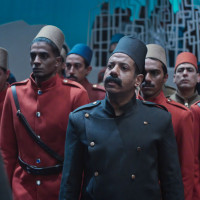
In the British Pavilion, Ghanaian-British filmmaker John Akomfrah creates his own microcosm with Listening All Night To The Rain. His six-hour-long film on migration and colonialism is divided into eight cantos, each accompanied by the sound of water, in addition to archival footage shown across numerous screens. Akomfrah delves into British colonial history, drawing inspiration from American painter Mark Rothko’s darkly diffused and beautiful universe. Listening All Night To The Rain resonates with Rothko’s tones.
The next day, over ten people stand and imitate the war sounds: »SSSSSS THUKH«
In the German Pavilion, theater and opera director Ersan Mondtag draws on his Turkish father’s history. His father died from asbestos poisoning as a poor worker in Germany. The audience walks through a three-story house infested with mold, coming up close to the singers who huddle together, much like immigrants always do.
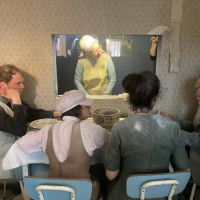
We are witnesses; we cannot help them because we are merely spectators. It is a performance, and we are gripped by a chilling helplessness. Outside Mondtag’s installation, Yael Bartana’s sci-fi piece about an escape into outer space echoes.
In the Polish Pavilion, the sound of war dwells. In the video installation Repeat After Me II (2024), Ukrainians mimic the sounds of mortars and sirens. The sounds are subtitled, and microphones are available for the audience. On my first visit, no one was at the microphones. The next day, over ten people stand and imitate the war sounds: »SSSSSS THUKH«.
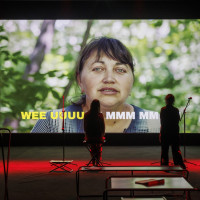
The work consists of two films. In the first, from 2022, the Ukrainian collective Open Group interviews people in Lviv. In the second, from 2024, the Ukrainians are far from the bombings. A woman in New York, with Manhattan as her backdrop, makes war sounds with her mouth. Using a simple method—like Claude Lanzmann did in his film Shoah – the Ukrainians recreate the horrific, repeating the sounds over and over, articulating the unthinkable with their tongues, making noises like sirens, grenades, artillery. The microphones in this karaoke bar are turned on, the floor is red carpet, and we struggle to grasp the horror, summoning the courage to step onto the stage ourselves.
If the drones produced by the fruits had colors, they would be faded, pastel, always on the verge of the next stage of total decay
Orchestra of Rotting Fruits
In the Japanese Pavilion, Yuko Mohri has attached electrodes to fruits that slowly decay. Bananas, apples, and grapes are arranged on furniture the artist found in Venice. The electrodes convert their moisture into electrical signals, creating a fascinating soundscape – a kind of free improvisation. Spending time in this room – something you genuinely feel compelled to do – feels calming. Water drips throughout the room, a reference to leaks caused by earthquakes in Tokyo’s metro system.
The water flows through tubes, activating a snare drum, which mixes with the droning sounds. If the drones produced by the fruits had colors, they would be faded, pastel, always on the verge of the next stage of total decay. But the rhythms remain playful, and Yuko Mohri’s orchestra of rotting fruits – displayed in all their fragility – is a completely organic ensemble that takes its time and will play until it can do so no longer.
Yes, the overlooked are exhibited all over Venice. Stranieri Ovunque. But we hear them too
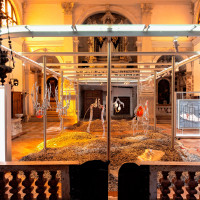
A similarly immersive exhibition can be found in the Lithuanian Pavilion, housed in an 18th-century church. Inflamed quickly gained a reputation as the best-curated exhibition at this year’s biennale. It consists of aluminum and glass sculptures by Pakui Hardware, paired with Marija Teresė Rožanskaitė’s modern figurative paintings. Inflammation is understood as a metaphor for the systemic harm inflicted on humanity and the planet. The electronic soundtrack, though not technically complex, adds to the sensation of the space, which echoes, trembles, and pulses like delicate muscles striving for survival and healing in a hospital laboratory – now relocated to a Catholic space that has long been a place of spiritual refuge and has heard centuries of laments, perhaps offering comfort.
Follow the Bats
The Venice Biennale is always noisy. Art crowds from around the world flock together (although with fewer yachts this year), the queues are massive, and you accept the overwhelming nature of the »Olympics of the art world«. Who is a stranger here, where everyone is present at the same time?
When nature becomes culture, sometimes it speaks in a way you will only understand some time later
Though Manal AlDowayan’s multimedia installation Shifting Sands: A Battle Song in the Saudi Pavilion occupies a vast space, it is a quiet room. AlDowayan has recorded the hum of dunes, and we listen to the world’s largest desert, the Rub’ al Khali, known for its ability to sing. Her work addresses visibility and representation and includes the hum of 1,000 Saudi women and girls recorded during workshops.
Yes, the overlooked are exhibited all over Venice. Stranieri Ovunque. But we hear them too. And the unheard – the marginalized sounds – are given a world stage. There are both atmospheric and jarring clashes between familiar and foreign sounds, songs, and scents – until they are no longer foreign, until we all become familiar. Among the bodies of dead migrants, spiritual worlds echo, and some exhibitions, especially the Japanese one, create a microcosm of embrace.
When nature becomes culture, sometimes it speaks in a way you will only understand some time later.
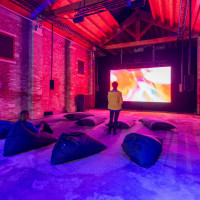
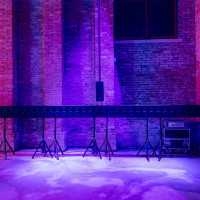
A little away from the Giardini and Arsenale, in the Catalonian exhibition Bestiari, you have the art to yourself. And nature. On a screen, grunting wild boars roam a forest. A speaker system – probably the most advanced at the biennale – plays sounds recorded in various nature parks in Catalonia. Occasionally, you hear the sound of a choir singing. Carlos Casas and Filipa Ramos have created an acoustic wonder, and perhaps here, among the buzzing bees, wild animals, and clever bats – known in Catalan as »winged rats« – we can learn something about navigating the dark. Bats find their way acoustically, through their hearing. Listen and learn. Follow the bats.
Venice Biennale, April 20 – November 24, 2024
English translation: Andreo Michaelo Mielczarek
Proofreading: Geoff Cox
